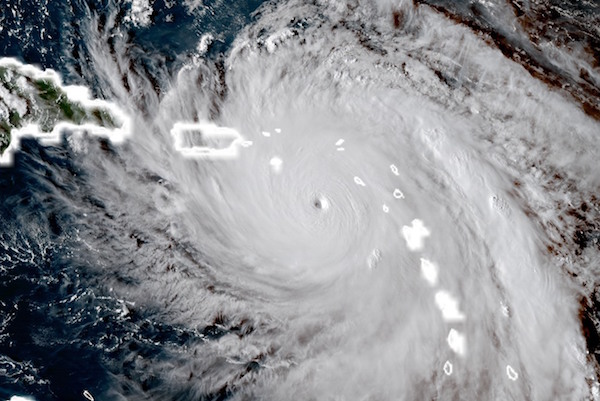Moving Counter-Clockwise: Lessons from Hurricanes, Floods and Earthquakes
 Karen GrossThe plethora of natural disasters raises all sorts of complicated but expected issues – from discussions of the legitimacy of global warming to the adequacy (or lack thereof) of on the ground relief efforts.
Karen GrossThe plethora of natural disasters raises all sorts of complicated but expected issues – from discussions of the legitimacy of global warming to the adequacy (or lack thereof) of on the ground relief efforts.
One would have thought that post-Katrina, we would be ready, willing and able to provide immediate relief to those in need of disaster relief. It would be good, too, to realize that Puerto Rico is part of America --- not a city or state to be sure but legally and importantly part of the United States. The individuals there are Americans and yet even a fly-over by our President is lacking. His newfound interest (as of yesterday and today) seems to have been spurred on by bad press. And yes, Mexico is a different nation but an important neighbor. And the Islands in the Caribbean, some American and others British and Dutch are in deep need and, if we are being self-centered about it, serve many Americans and American businesses.
The needed relief can and does take many forms: clean water (and the capacity to make clear water including from salt water); medical supplies and medical infrastructure including to enable continuing care for those with chronic illnesses or acute diseases); alternative power supplies to enable electricity, water pumps and connectivity; tower and satellite access for planning and Internet; educational resources when schools are shuttered; road and other infrastructure reconstruction; home rebuilding; psychological support for those affected and for first responders; reopening of transport systems and drop shipping from planes and helicopters to areas cut off from human access.
Here’s what I don’t understand. We have had remarkable advances and innovations in technology since Katrina. We have companies and open source resources (programs; data; capacities) that have products that can facilitate disaster relief, disease prevention and treatment, food delivery, power sources, Internet access and educational materials. We can have coordinated efforts and public-private partnerships. Each group can uplift the other in terms of time, tactics and talents, leveraging human and technological resources. Look at the amazing work of the National Health IT Collaborative (NHIT), which is now launching an effort in Puerto Rico.
 Hurricane Maria devastating the Leeward Caribbean islands and about to strike Puerto RicoBut, despite capacities, we have been stunningly slow in moving these new services into disaster areas. Instead of technology advancing the ball, it is as if we are moving our clocks backwards. Sure, in the absence of cell towers, creative workarounds have been enabled like AT&T facilitating communications to/from the mainland for its customers.
Hurricane Maria devastating the Leeward Caribbean islands and about to strike Puerto RicoBut, despite capacities, we have been stunningly slow in moving these new services into disaster areas. Instead of technology advancing the ball, it is as if we are moving our clocks backwards. Sure, in the absence of cell towers, creative workarounds have been enabled like AT&T facilitating communications to/from the mainland for its customers.
Yet, consider these available technologies that have not yet found their way to disaster areas in sufficient numbers (and note meanwhile our capacity to move troops and ships and expertise into the Pacific and Afghanistan).
Ships (military and otherwise) can be desalination sites and mobile hospitals. Major communications carriers like Verizon and AT&T can provide cell phones and power packs to enable access to satellites. Health care records can be transported to the cloud to facilitate ongoing care, something of key importance as people are moved to new medical facilities. We can drop ship medicines and food and supplies for rebuilding or digging out or down.
We can bring in bridges (measured and prepared offsite with the aid of 3D technology. We can bring in pre-fab homes and ways to dry out flooded land. We can teach through the cloud. We can provide robots to perform many functions, both menial and more advanced. We have programmers and experts who could be on the ground making improvements. We have data that can become a service provider not a mere repository of information.
All of these technologies are available. Many are free or could be donated. Can someone explain to me why we are days and weeks into these disasters across the globe and we still have not deployed these technologically advanced systems?
I can’t come up with an answer, just guesses. One would think these interventions would have been deployed in the first 24 – 72 hours. Are they too expensive? Are we not organized well? Have we not incorporated technology and innovation (and accompanying training) into our disaster relief planning and delivery?
It appears, as a starter example, that a gap exists between information technology specialists and public health and emergency personnel. Overall, intergovernmental attention to data management is lacking. We are not collaborating in a timely way to share data and data needs to meet the inevitable and known challenges created by emergencies: notifiable disease reporting, outbreak detection, evacuation evaluation, and public communications in relation to disease outbreaks.
Seems to me, not to be too cynical here and regardless of the reasons, that we haven’t taken technology and used it to bring us forward. Instead, we are moving the clock back – because it is easier because it does not involve change, because it requires less training and less experimentation?
Time is a wasting. Technology exists. We need collaboration with common standards for communicating and educating – as pilots discovered long ago to prevent catastrophe. It is vastly too difficult to get different parts of government to talk to each other – within one nation.
To me, we can’t wait anymore. Can’t we mobilize now, before it is too late? And, we have experience being too late (the US military and Ebola is but one example). Let’s not let history repeat itself. Message to all: Embrace technology, Innovate, Communicate, Coordinate and Use Open Resources. Today.
Note: This article was inspired by the work of many people, including MW. His commitment to helping others is not only commendable; it is remarkable. And he allows me to realize the many opportunities that exist to help others at a certain age and stage. Indeed, one could argue it is our obligation and responsibility after a full successful career.
- Tags:
- 3D technology
- acute diseases
- alternative power
- AT&T communications
- bridges
- Caribbean
- chronic illnesses
- clean water
- common standards
- disaster areas
- disaster relief
- disaster response
- disease outbreaks
- disease prevention
- disease treatment
- earthquakes
- educational materials
- emergency personnel
- evacuation evaluation
- floods
- food delivery
- ground relief efforts
- health care records
- Hurricane Katrina
- hurricanes
- infrastructure reconstruction
- intergovernmental data management
- Internet access
- Karen Gross
- Leeward Caribbean islands
- medical data interoperability
- medical data share
- medical infrastructure
- medical supplies
- Mexico
- National Health IT Collaborative (NHIT)
- notifiable disease reporting
- open source resources
- OpenEMR
- outbreak detection
- post-Katrina disaster response
- power sources
- pre-fab homes
- public communications
- public health personnel
- Puerto Rico
- technologically advanced systems
- United States
- Login to post comments